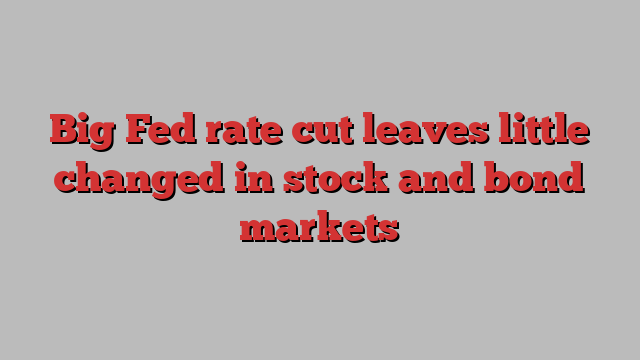
Stay informed with free updates
Simply sign up to the Capital markets myFT Digest — delivered directly to your inbox.
Investors braced for wild market moves ahead of Wednesday’s Federal Reserve meeting. But by day’s end, there was little sign of a momentous shift or the beginning of a new era.
The US central bank kicked off a new rate-cutting cycle with a larger than normal cut, but despite some mild swings during chair Jay Powell’s press conference, major stock benchmarks and government bonds ended the day barely changed compared with where they were before the Fed’s announcement.
The S&P 500 closed the day 0.3 per cent lower, in contrast to pricing in options markets earlier in the week that had predicted a more than 1 per cent swing. The two-year Treasury yield, which is particularly sensitive to monetary policy, dipped just 0.02 percentage points between the policy announcement and Wednesday evening.
“In the grand scheme of things, compared with the volatility this market has seen over the last few months, the response has been taken in stride,” said Michael de Pass, global head of rates trading at Citadel Securities.
“We received more clarity on the Fed’s reaction function being skewed toward the labour market, but the market had already priced that in to a fairly aggressive extent.”
A rate cut of some sort was widely expected, but there was still uncertainty over the size of Wednesday’s reduction and how quickly the Fed would signal further moves as it tries to balance the two sides of its mandate to control inflation and protect the labour market.
“This is a Fed that is being very careful and deliberate,” said Gargi Chaudhuri, BlackRock’s chief investment and portfolio strategist for the Americas. “They’re doing whatever they can to make sure the labour market remains as solid as it is now . . . But they’re also telling us not to get used to [50bp cuts]. This is not the new pace.”
Lower interest rates are traditionally considered a positive for stock markets, as they stimulate the economy, reduce companies’ debt burden and encourage investment in riskier assets. However, investors have been wary that a more aggressive cycle of rate cuts could indicate worries about a more severe economic downturn that would hit corporate profits.
Chaudhuri said the slight decline in stocks on Wednesday was more a reflection of investors taking profits ahead of a seasonally weak period rather than a reflection of newfound worries about the economic outlook. The S&P 500 has risen almost 18 per cent this year and briefly touched record highs on Tuesday and Wednesday before pulling back.
“I would not be surprised to see some pullback [in equities] over next couple of weeks but only because we had such a strong performance up until this point,” she added.
Powell had previously emphasised the central bank was intent on protecting the labour market, and officials, including Fed governor Christopher Waller, had signalled in advance of the meeting that they were not afraid of making larger cuts if needed.
“The groundwork had been laid for a 50bp cut,” said Sinead Colton Grant, chief investment officer at BNY Wealth Management. “If you went back six weeks, there was a narrative that it would imply the Fed was concerned about something the market isn’t seeing . . . I think the September labour market report really helped convince the market that we probably need a little bit more than 25bp.”